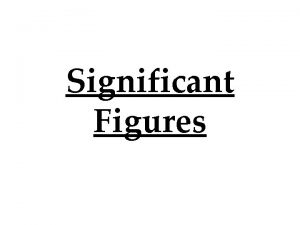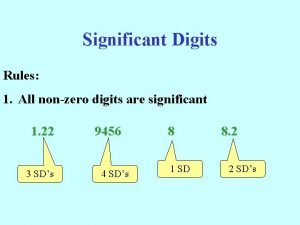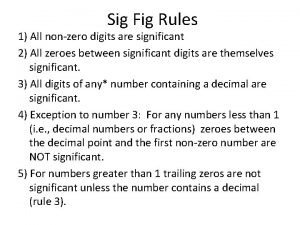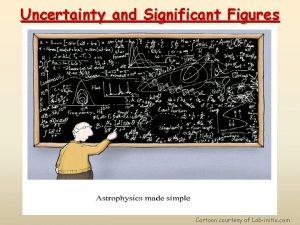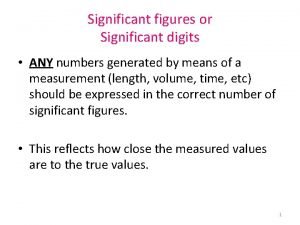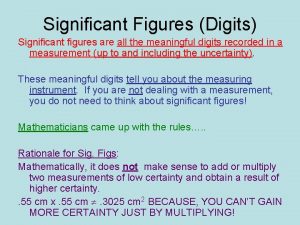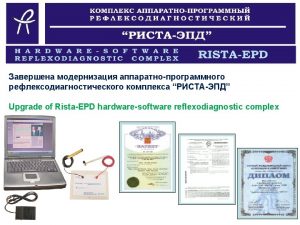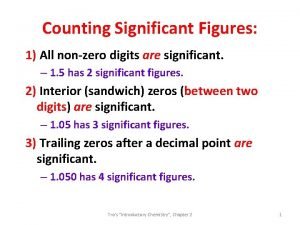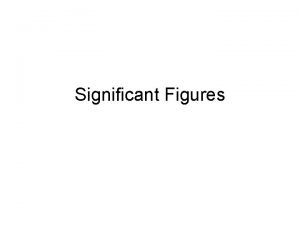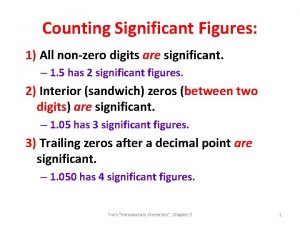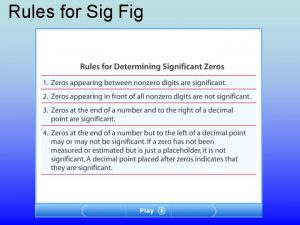Sig Fig Rules 1 All nonzero digits are










- Slides: 10

Sig Fig Rules 1) All non-zero digits are significant 2) All zeroes between significant digits are themselves significant. 3) All digits of any* number containing a decimal are significant. 4) Exception to number 3: For any numbers less than 1 (i. e. , decimal numbers or fractions) zeroes between the decimal point and the first non-zero number are NOT significant. 5) For numbers greater than 1 trailing zeros are not significant unless the number contains a decimal (rule 3).

Practice • • 726 ______ s. f. (Rule #1) 3608 ______ s. f. (Rule #2) 24, 090, 007 ______ s. f. (Rule #2) 230. ______ s. f. (Rule #3, this is BAD form!) 230. 0 ______ s. f. (Rule #3) 45. 08 ______ s. f. (Rule #3) 670. 003 ______ s. f. (Rule #3)

More practice • • 0. 0024 ______ s. f. (Rule #4) 0. 000006750 ______ s. f. (Rule #4 & #3) 5. 11 x 10 -4 ______ s. f. (Rule #4) 2. 600 x 10 -8 ______ s. f. (Rule #4 & #3) 3, 100, 000 ______ s. f. (Rule #5) 3, 100, 000 ______ s. f. (Rule #5 & #3) 4. 56 x 1016 ______ s. f. (Rule #5) 2. 90 x 104 ______ s. f. (Rule #5 & #3)* • If a number is expressed in sci. not. It is generally assumed that ALL the digits • to the left of the multiplication sign are significant. This is essentially rule #3.

Terra Giga T 1012 Mega kilo G M k 109 106 103 base milli micro nano pico fempto m µ n p f 10 -3 10 -6 10 -9 10 -12 10 -15 centi C 10 -2 What this chart means: For big things: 1 Terrameter = 1012 Meters OR 10 -12 Terrameters = 1 meter For little things: 1 micrometer = 10 -6 Meters OR 106 micrometers = 1 meter

Making conversions Step 1: Write down a conversion factor between the two types of things you are comparing. If you don’t know it, look it up. * *You will need to know your metric prefixes and their values for the exam & the rest of the year! Step 2: Use “railroad tracks” or “factor-label” method to set up conversion formula. If you need to make multiple conversions, set each one up one at a time. Step 3: Multiply across the top, multiply across the bottom, divide top by bottom. Answer. Include any units remaining that did not cancel.

Practice 240 Mm = _____ m 736 nm = ______ m Ans: 7. 36 x 10 -7 m 1 Mm = 106 m

More practice 6. 42 m = ______ km Ans: 6. 42 x 10 -3 km 42 m = ______ µm Ans: 4. 2 x 107 µm

Still more practice (the “hard” ones) 12. 3 Gm = _______ pm 60, 000 fm = _______ km Ans: 6 x 10 -14 km 1 Gm = 109 m 1 m = 1012 pm 1 fm = 10 -15 m 1000 m = 1 km

Weird, multi-dimensional conversions • Pre. AP packet number 8 on dim. analysis wrksht. 1 mile = 1609 meters 12 mi/hr*s = ______ m/s 2 1 hr = 3600 seconds

Pre. AP Students: • If you don’t know the conversion factor look it up: – In a book – On the internet (wikipedia is good) – On a website: http: //www. onlineconversion. com – “Multi. Convert” app for smartphone If you use the website or the app: don’t cheat. Don’t go straight to the result, even if you can. This does you no good on your upcoming test or in general. Just use it to find the conversion factors. You could also use it to check your work
